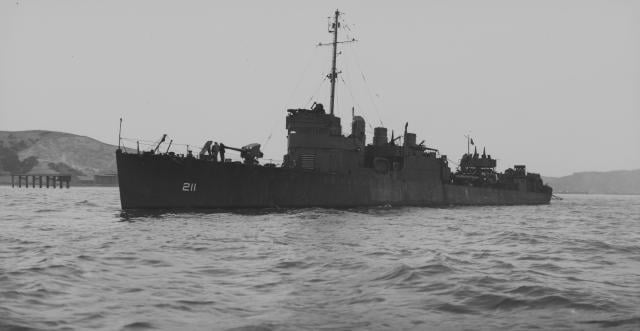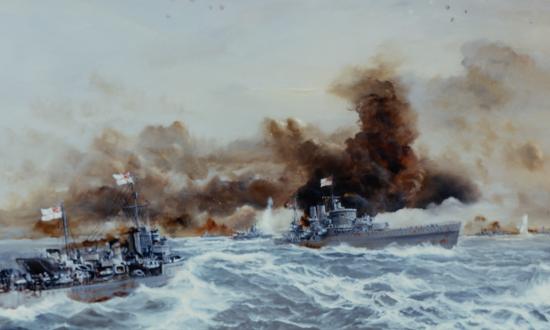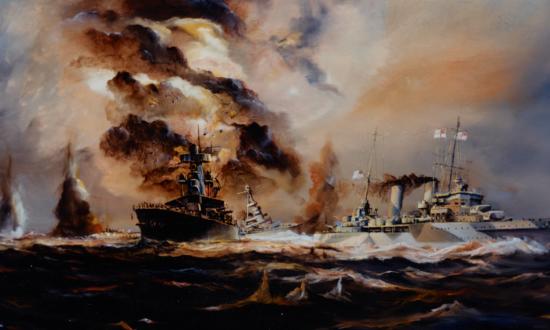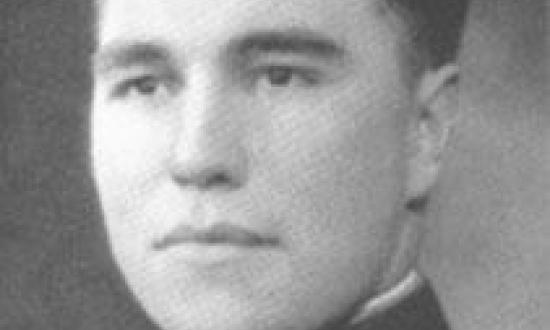Arriving in Surabaya after midnight, the destroyer USS Alden (DD-211) waited nearly two hours for her turn at Holland fuel pier. When the ship finally pulled alongside, the weary crew found that in the face of the impending Japanese invasion, the pumping stations that were normally manned by Javanese workmen had been abandoned. Barely able to walk by now, exhausted sailors dragged the heavy fuel hoses aboard, while others figured out how to operate the Dutch pumps. After a frustrating delay, the black hoses finally pulsed as fuel began to flow into the cavernous tanks. With nothing more to do while the fuel flowed, several of the men dropped to the deck, falling instantly to sleep.
Her fuel at last replenished, the Alden anchored just before sunrise. Lieutenant Commander Lewis E. Coley had slept briefly in his captain’s chair on the bridge while Lieutenant Commander Ernest Evans supervised the refueling. An hour into the morning watch, both men were red-eyed as they leaned on the starboard bridge wing rail and conferred over lukewarm cups of black coffee. As the heat of the day set in, they watched as a pair of boatswains’ mates sprayed water over the sunlit forecastle and clouds of steam rose from the deck.
It was not at all clear what was to be done now in the aftermath of the fruitless battle. The Alden had fuel, gun ammunition, and some depth charges, but no torpedoes. Food was becoming a concern. With Dutch Rear Admiral Karel Doorman and the remainder of the Combined Striking Force gone God-only-knew where, there were no ships to screen, and any offensive actions against the Japanese seemed suicidal at best. It seemed the Americans’ best chance was to try to get through to an Allied base, but with the noose tightening around Java, those options were diminishing quickly.
The shocking news of Singapore’s fall and their recent experience in the Java Sea made it abundantly obvious that all the East Indies would soon join the burgeoning Japanese Empire. The Philippines was out of the question since there were reports that the U.S. and Filipino forces had abandoned Manila and had retreated to the Bataan Peninsula and the island of Corregidor. With no hopes of a relief force, it seemed clear that it was only a matter of time before the Philippines would fall and that retreat was now the only sensible option, no matter how distasteful.
(U.S. Naval Institute Photo Archive)
Escape Through the Bali Strait
Commander Thomas Binford’s plan of retreat was a good one, though by no means foolproof. He chose the Bali Strait because it was deep enough to allow passage for the destroyers but too shallow for cruisers and battleships. Once through, they would emerge into the Indian Ocean where they might still be subjected to air attacks, but it was hoped they would not encounter any enemy surface forces there, since it seemed likely the Japanese would be preoccupied with the final conquest of Java.
The destroyers would wait until dark to make their eastward move and would be able to transit the strait before the sun rose again. But the weather forecast and the Nautical Almanac predicted a cloudless night with a bright waxing moon, just a few days short of full. They would have to hug the land as close as they dared on the west side of the strait, hoping to avoid being silhouetted by the moon, which would be hovering on their port beam as they dashed southward.
After some brief but desperately needed rest and the first of many meals of canned Spam, the boatswain’s mates of First Division began painting over any brass fittings that might reflect the anticipated moonlight in the coming night. Gunner’s mates fussed over their weapons, reapplying lubricants that had lost some of their viscosity in the searing Indonesian sun and reinserting tampions into the muzzles after yet another inspection of the still-pristine inner barrels. Two signalmen on opposite ends of the signal bridge lazily exchanged semaphore messages about real and imagined encounters with members of the opposite sex. Seamen apprentices scrubbed greasy pans in the scullery, while others in the ship’s laundry hefted loads of dungarees—still wet with accumulated perspiration—into the gaping maws of the large washing machine. Two of the junior officers who would be standing bridge watches that night studied the Dutch chart of Bali Strait, while a freckle-faced quartermaster carefully wound the chronometers nearby. In the tiny sick bay, a pharmacist’s mate organized battle dressings according to size, then prepared a batch of salt pills for issue to the crew at the next meal.
In the early afternoon, the chief storekeeper took a small working party ashore on a scavenging foray and returned with two crates of papayas and an emaciated, freshly slaughtered chicken. They reported that they had seen an American Clemson-class destroyer— the USS Pope (DD-214)—moored about a mile away around a bend in the docks. The Alden’s sailors had asked the Pope’s crew if they would be joining them for the planned escape that night but had been told that because her torpedo tubes were still full, she had been ordered to escort the Exeter, which had managed to limp into Surabaya and was undergoing emergency repairs not far away. Because of the Exeter’s deeper draft, they planned on using the Sunda Strait between the western end of Java and Sumatra, and then continue on to Colombo, Ceylon. Only later would the Alden’s sailors learn that both the Exeter and Pope were sunk by Japanese aircraft and a cruiser before they even reached the strait.
For many of the Alden’s crew, the hours seemed to crawl by as they watched the blazing sun inexorably but imperceptibly descend toward the western horizon. For others, these few hours of reprieve before they would again venture into hostile waters were escaping their grasp at too rapid a rate. They already had satisfied the young man’s desire to prove himself in combat and were eager to trade the Java Sea—now for all intents and purposes a Japanese lake—for the relative safety of the Indian Ocean and the continent of Australia more than a thousand nautical miles to the southeast.
(U.S. Naval Institute Photo Archive)
Hugging the Java Shore
At last, the waiting was over, and the destroyers of Division 58 got underway and headed to sea. The Edwards (DD-619) and Alden shifted colors at1700, followed by the Ford (DD-228) and Paul Jones (DD-230) a half hour later. In the remaining daylight, Binford chose to use the western channel out of Surabaya, in case any Japanese aerial snoopers were watching—hoping that they would conclude that he would be heading west across the Java Sea—before doubling back and heading out the eastern channel toward the oncoming darkness and Bali Strait.
As predicted, it was a clear night, and the bright moon cast its unwanted light over the area, its reflection presenting a shimmering path that would be welcome under other circumstances. A light breeze from the southeast barely stirred the placid waters as the ships crept along at bare steerageway, trying to keep their telltale wakes from further revealing their presence.
A Dutch patrol craft prowled along the southern edge of the minefield as they passed. The Dutch captain either had not spotted them or had recognized them for who they were. In either case, the small craft moved on, steady on her original course.
Shortly after midnight, the skulking destroyers left the minefield behind and entered the narrows of Bali Strait. Almost immediately, the Alden’s forward lookouts reported several craft ahead, but binoculars revealed the soft glow of white sails, a good sign that they were merely local fishing boats, presumably no threat.
The men on deck wore kapok lifejackets and had blackened their faces and hands with shoe polish. With their sleeves rolled down and their trousers tucked into their boots to protect them from flash burns, dark rivulets of perspiration trickled down their faces and necks, staining their buttoned collars.
The ships hugged the Java shore as closely as they dared, all placing their faith in the Edwards’ navigator as his ship led the way, relying on a mix of Dutch charts and American ones whose data was suspect at best. The tension was palpable as the men on watch scanned the waters ahead, hoping not to see the telltale froth of a coral reef that had grown up in the years since those charts had been printed.
The moon was now about 45 degrees above the horizon and only occasionally shrouded by a passing cloud. At 0115, as the strait began to widen, Binford ordered his ships to increase speed to 25 knots. The acceleration brought a relative wind that was welcomed to the sweltering sailors on deck.
Nearly an hour passed uneventfully, and many began to hope they were going to make a clean escape. Those hopes were subsequently dashed when a dark shadow appeared ahead off the port bow. As the distance closed, the shadow took on the form of a destroyer that appeared to be patrolling the southern end of the strait. For several tense minutes nothing happened. Then, from farther south, flashing lights shone dimly as they winked out coded messages. Soon, two more destroyers emerged from the darkness, their distinctive outlines leaving no doubt that they were Japanese.
It seemed they had not spotted the Americans against the dark shoreline. But at about 0230, the navigator’s chart showed a reef off the eastern tip of Blambangan Peninsula looming ahead, and Binford had no choice but to lead the column eastward to prevent running aground. The Japanese at last spotted their adversaries and opened fire. The night was lit up by the flashes from the Japanese guns, and the first salvo straddled the Ford. Several more rounds landed close aboard, but she was not hit as she heeled over in a sharp evasive turn aiming for the splashes of the unsuccessful rounds in hopes that the Japanese would be adjusting their fire and not hitting the same spot. This was the established tactic that Evans once had explained to his young son, while reading to him about the Battle of Jutland years before. Now he was seeing it in action.
Binford ordered 27 knots and “Commence firing.” By now the range to the Japanese destroyers was about 5,000 to 6,000 yards, and the Alden and the others responded with their 4-inch guns, using a continuous 50-yard “rocking ladder.”—“walking” the point of aim back and forth across the target at predetermined increments. With the exception of the Edwards, who did not use her forward guns for fear of the flashes blinding the lookouts from seeing navigational hazards ahead, the American ships put out a high volume of fire. None of the shots found their targets, but the continuous barrage kept the Japanese from closing the range.
Binford later reported, “An attempt was made to keep up a rapid volume of fire rather than an effective fire . . . to keep the enemy outside effective torpedo range.” Although none of the U.S. ships had torpedoes, the enemy did not know that, so the torpedomen fired blank torpedo impulse charges in their empty tubes, hoping the Japanese would see the flashes and assume torpedoes were on the way. On the Alden, several sailors furthered the ruse by retrieving empty shell casings from the deck and tossing them overboard in front of the torpedo tubes, hoping the Japanese would think the splashes were from torpedoes hitting the water. Whether it worked or not, the Japanese ships came no closer but continued to hammer away with their guns.
For Binford, it was tempting to press the attack, since the Americans had a four-to-three advantage, but their lack of torpedoes, the uncertainty of the navigational picture, and the possibility that more Japanese ships might be in the area to join the fray caused him to choose escape over further engagement. He turned his destroyers southward again and left the enemy ships behind in the Bali Strait. Eventually both sides ceased firing and the flashes of gunfire gave way to the steady light of the placid moon.
‘A Losing Campaign But Not a Lost Cause’
Lieutenant Commander Mack later recorded in his 1943 U.S. Naval Institute Proceedings account:
Every hour that passed put 30 miles between us and the nightmare on Java. We had done all we could. Now we could only hope to escape to fight another day. Dawn found us 120 miles south of Java still racing southward. Anxiously we searched the sky for aircraft. Down below in the radio shack, reports were coming in of attacks by Jap carrier aircraft on other ships fleeing from Java. Somehow they missed us, as we steamed on and on without slowing. All that day and night and the next day we kept going until we knew that we were safe. . . . The old U.S. destroyers which fought so well will probably never fight again. They have since been retired to pasture, to honorable retirement. . . . The officers and men who fought on them have gone to other duties on other ships where they will someday help to avenge their comrades who were less fortunate during those last fateful days of February 1942. They fought a losing campaign but not a lost cause.
Ernest Evans had received his baptism by fire, and considering the circumstances, he and his shipmates had performed as well as could be expected. But for this Native American with a warrior’s heart, it would be the retreat that remained foremost in his mind. Less than two years later, he stood on the fantail of his brand-new destroyer speaking at her commissioning ceremony. In the tradition of the Navy’s iconic hero John Paul Jones, Commander Evans told his crew and the assembled guests that, “This is going to be a fighting ship, and I intend to go in harm’s way.”
And he did!










